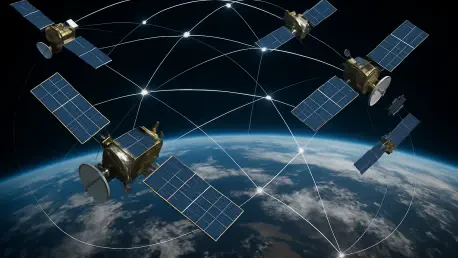The ongoing debate over Space Force’s satellite constellations, especially concerning the Tranche 3 Transport Layer, highlights significant uncertainties and challenges in advancing technology vital for national defense. Initially, Tranche 3 was expected to receive funding in fiscal 2025, marking a critical milestone in the Pentagon’s Joint All Domain Command and Control system. Yet, the latest decisions and budget reallocations cast doubt on the future, signaling potential shifts in focus from government-funded projects to exploring commercial solutions. This shift is a response to both budgetary constraints and the pursuit of more versatile and advanced technological solutions.
The Uncertain Future of Tranche 3
Tranche 3 Faces Budgetary and Strategic Challenges
The allocation of resources for the Tranche 3 Transport Layer has been a contentious issue amidst shifting priorities and budget reevaluations. While Tranches 0, 1, and 2 have secured $1.8 billion in the 2026 budget, President Trump’s proposed budget for 2026 surprisingly leaves Tranche 3 without allocated funds. This decision raises questions about the sustainability and strategic direction of Tranche 3, juxtaposing it against newer initiatives like the forthcoming “MILNET.” MILNET, a cutting-edge Low Earth Orbit satellite communications architecture, promises to redefine military communications with its scalable and adaptable nature, appealing to both strategic planners and financial watchdogs alike.
The anticipated ambiguity surrounding Tranche 3 stems from sophisticated deliberations concerning its replacement or enhancement with commercial alternatives. As the Space Development Agency scrutinizes its current plans, lawmakers express unease about potential impacts on security and technological innovation. During recent hearings, Chief of Space Operations Gen. B. Chance Saltzman encountered pointed inquiries from prominent legislators about the ongoing debates. Although Saltzman voiced sustained support for Tranche 2, his remarks conveyed that Tranche 3 remains unsettled, prompting the exploration of existing commercial solutions. This approach, if fully realized, may yield a robust, flexible satellite network while preventing vendor monopolization that risks escalating costs and compromising availability.
Legislative Scrutiny and Strategic Evaluations
In facing these challenges, strategic considerations play a key role in the unfolding scenarios surrounding Tranche 3, shaping pathways for future developments. The potential reliance on commercial entities for satellite communications could offer innovative prospects that might complement existing military capabilities. MILNET, a system shrouded in secrecy, has emerged as a potential game-changer that emphasizes adaptability and resilience. It aims to address mission-critical needs ranging from combat power to global data transport while ensuring the multi-vendor inclusivity of the system.
Conversations around reliance on companies like SpaceX for satellite support reflect concerns about over-dependence on single contractors. The Department of the Air Force is committed to maintaining diversified vendor involvement to ensure competition and prevent reliance on dominant players. This pursuit of a multi-vendor satellite ecosystem underscores the delicate balance between securing innovative solutions and sustaining strategic alliances within the defense sector. It remains a complex chess game where budget, technology, and national security interests entwine, demanding a forward-thinking approach that embraces both prudent caution and calculated risk.
The Defense Department’s Strategic Pivot
Balancing SATCOM Needs Amid Financial Constraints
In parallel with ongoing budget considerations, the Department of Defense has signaled a shift toward solidifying requirements for proliferated SATCOM capabilities that align with strategic imperatives. The SDA, guided by shifting priorities, postponed contract solicitations for Tranche 3, hoping for clearer fiscal insights. This delay is not merely a funding issue but a pivot toward redefining the scope and scale of satellite communication strategies. Originally charted for deployment starting in 2028, Tranche 3 satellites are now expected to experience extended timelines, presenting an opportunity to reassess requirements in line with advancing technologies and emerging global threats.
By leveraging insights gained from Tranches 1 and 2, SDA Director Derek M. Tournear remains engaged in crafting future strategies for Tranche 3, even as internal discourse continues. The lessons from earlier tranches hold promise, serving as valuable blueprints for integrating technological advancements in future projects. An underlying aim is to cultivate a continuum of innovation, seamlessly connecting insightful learning from previous experiences with fresh technological imperatives. This engagement allows the SDA to adapt and evolve, ensuring readiness for contemporary combat demands and positioning itself as a vanguard in space-based wartime communication.
Exploring Dual Approaches to SATCOM Solutions
The discussions around Tranche 3 extend into additional dimensions, especially considering the potential Tranche 3 of the Tracking Layer for missile detection and warning. The SDA’s dual approach, emphasizing both transport and tracking infrastructure, underscores its strategy of comprehensively addressing both immediate and long-term defense needs. The latest discussions reflect an integration of internal research with external partnerships to meet advanced warfare challenges. In this context, the balance between domestic capabilities and commercial collaborations offers a versatile path forward, fostering innovation and enhancing preparedness.
Focusing on the MILNET architecture, the prospect of a scalable, multi-vendor satellite communication network reflects a forward-looking stance on defense satellite infrastructure. The Department of the Air Force initially allocated $277.4 million toward establishing this infrastructure within the 2026 fiscal framework. The initiative’s broader goal is to establish an interconnected system with diverse optical crosslinks, emphasizing adaptable, vendor-agnostic architecture. This reinforces a commitment to improving satellite communication systems that satisfactorily align with defense strategic objectives and operational imperatives, marking a deliberate march toward modernized military readiness.
A Strategic Path Forward
The ongoing debate surrounding the Space Force’s satellite constellations, notably the Tranche 3 Transport Layer, underscores significant uncertainties and challenges in advancing essential technology for national defense. Initially, Tranche 3 was slated to receive funding in fiscal year 2025, representing a crucial development in the Pentagon’s Joint All Domain Command and Control system. However, recent decisions and budget reallocations have cast doubts on its future, suggesting potential shifts from government-funded projects toward exploring commercial alternatives. This shift is largely in response to budgetary constraints and the desire to pursue more dynamic and advanced technological solutions. The complexities of defense funding, coupled with the rapid pace of technological advancement in the commercial sector, are driving a reevaluation of priorities. By leveraging commercial innovations, the Space Force aims to enhance capabilities while managing costs, thus ensuring the continued competitiveness and adaptability of their defense systems.









